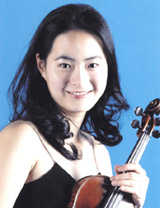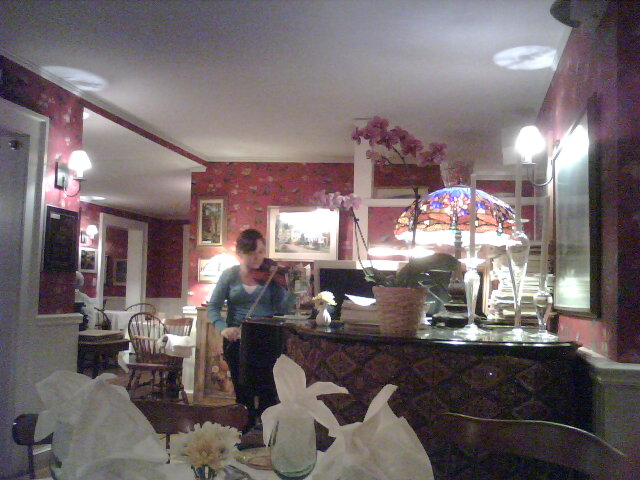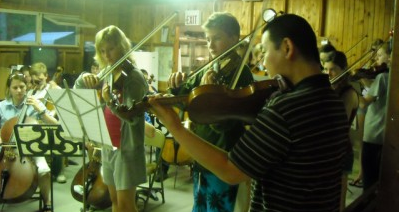Many thanks to David Weininger from the Boston Globe, for visiting our season opener, and writing up a review! Don't forget to leave a comment on the Boston Globe site through the link above, letting their wider audience know how you felt about the concert!
The End of Lunacy
Well, the Criers can take a deep breath. One-third of Season 3 is in the books, and I think we are all looking forward to a couple days of recovery. Out biggest audiences yet seemed to really take to what was, musically, one of our "crunchiest" programs ever. Christopher Hossfeld's concerto GROSSO received a well-deserved standing ovation for its Jordan Hall world premiere. An incredibly diverse crowd very nearly filled the church at our first Saturday-afternoon Jamaica Plain family-and-community concert - and lept to its feet after the INTENSE Schnittke. I love Beethoven symphonies as much as anyone on Earth, and who knows - maybe some day A Far Cry will do the BSO thing and perform the cycle self-conducted. But the one thing that I became absolutely convinced of this weekend, is that there's more than one way to generate excitement and attendance at classical music concerts. Warhorses are great, but people also want to be moved, and be moved by new, previously-undreamed-of experiences. As artists, the highest compliment that A Far Cry can receive is that we moved our listeners, and I was humbled and ecstatic to receive that compliment a number of times this weekend.
But enough from me - A Far Cry wants to hear from YOU. Were you at the concert(s)? Were you moved? Not moved? Almost-moved-but-with-thoughts-as-to-what-really-would-have-made-it-better? Leave a comment to this post, good or bad. Happy Crying!
Lunatic notes!
Want to head into our Lunatic concert knowing your stuff? Check out our program notes by the awesome young musicologist Kathryn Bacasmot! - - - -
The most terrifying things are those that appear familiar on the outside, but are alien within. For centuries societies blamed strange events or intermittent loss of sanity on the phases of the moon (luna). Lunatics, they called these victims. What was particularly disturbing about the idea of lunatics was their instability, or rather, their changeability. Trapped behind a familiar face was something all together alien that bent and disarmed the mind uncomfortably. On the program today are a series of pieces that that employ standard musical forms that are permutated through a lunatic lens. Like a fun house of mirrors, what you see is not always what you will get. Perception is not reality, or vice versa.
Did you know Battle Music was a legitimate genre? From the 16th century all the way into the 18th it was the rage. During the Baroque in particular, the music was not meant to describe specific battles or events, but was used more for “dramatic or allegorical purposes.” Charles Burney (1726-1814), the intrepid music historian, said of Heinrich Ignaz Franz von Biber (1644-1704): “of all the violin players of the last century Biber seems to have been the best, and his solos are the most difficult and most fanciful of any music I have seen of the same period.” Fanciful elements included his use of scordatura (mistuning), and compositions that included replications of the sounds of birdcalls and bells.
Biber’s Battalia à 10 was written in 1673. Keep that in mind, especially when you hear the second movement, Die liederliche Gesellschaft von allerley Humor (“The dissolute society of all sorts”), where each instrument is playing a different tune in different keys and time signatures to portray drunken soldiers. And you thought Charles Ives (1874-1954) was original. Biber also applied Claudio Monteverdi’s (1567-1643) Stile Concitato (“agitated style”), in which notes were rapidly repeated or trilled to evoke agitation. Watch for other effects throughout, such as the snapping of strings to imitate gunfire.
-----
This “Lunatic” program could be subtitled “Haunted by the Ghost of Arcangelo Corelli.” He was a Baroque era composer of “unparalleled influence,” over which it seems no one had a drop of anxiety. He appears a couple of times on this program, and in the Concerto Grosso No. 3 in C major of Francesco Saverio Geminiani (1687-1762), he is directly involved. Geminiani, not only a composer, but a renowned violinist, based this work on Corelli’s Violin Sonata Op. 5, No. 3. “Il Furibondo” (“the madman”) was Geminiani’s nickname bestowed upon him because of the expressivity of his compositional rhythms. Expressiveness equates madness? Now, I know you probably don’t equate the Baroque with emotional abandon, but back in the day, the Baroque was intense. It was the era that blossomed from the seconda pratica (“second practice”), the era of free dissonances, of music being liberated from primarily serving the text in a supporting role to taking center stage for the portrayal and evoking of abstract emotions.
As the Concerto Grosso No. 3 is based directly from Corelli’s Op. 5, No. 3, it is structured as a sonata di chiesa (“church sonata,” as opposed to a sonata da camera, or “chamber sonata”). Thus, it is constructed of four movements, alternating in tempo as slow-fast-slow-fast. The rhythmic and melodically dissonant rubs in this piece are delicious, like drops of honey on your fingers, sticky but sweet. If this constitutes madness, let’s all hope for a full moon.
-----
Christopher Hossfeld is going to tell you about his piece, concerto GROSSO, himself:
“concerto GROSSO can be seen in two ways: it is either a chamber piece for 18 strings, or a concerto for an 18 string orchestra where all players are soloists. In either case, it is 18 minutes long. Attempting to blur the line between chamber and orchestral music at this scale creates a grossness in the music: multiple overlapping layers, thick dissonant chords, a sense of rhythmic disorder and chaos, not to mention the physical challenge of holding the piece together. To balance this complexity the overall structure is simple: 3 movements with familiar forms: solo vs. tutti, fugue, and passacaglia/theme & variations. In one sense the forms are sterile and mathematical, while the music remains terribly personal as well.
All but Death—
The titles of the movements are literary (to a degree). Their sources will remain hidden for now (though a simple google search will reveal much), but their preoccupation is clear: death. These notes will not dwell on the personal motivations and emotions behind them: too detailed a revelation would hinder, not help, the appreciation of the music. concerto GROSSO is dedicated to the memory of a beloved aunt. The audience is invited to contemplate the movements as they are tonight, and perform further investigation if they wish.
The first movement is built on alterations between large tutti and small solo groups. The line between solo and tutti is intentionally vague. The urgent 16th notes of the theme are framed by full orchestral chords at the beginning, middle and end of the movement. As the final sounds fade, a familiar strain may be heard floating from the violas.
...AND ZOMBIES
An 18-voice triple fugue is quite disgusting to behold. Is it as disgusting as the undead, or the obsession with death?
l’enterrement d’une feuille morte
This passacaglia is part Chaconne in d minor, part Dido and Aeneas, and a lot of historical fantasy. The mood is both grave and playful. There are twelve sections in the piece (11 bass-line repetitions plus coda), each section is 12 bars long, and the whole movement is approximately 12 minutes.”
-----
Alfred Schnittke (1934-1998) suffered from a case of classic USSR creative claustrophobia. The soil beneath his feet was his homeland, familiar, and yet those who ruled upon it made it him a stranger in his own land. It has been noted Schnittke’s music inherits the Shostakovich tradition of “alienation expressed through irony.” Schnittke touted a musical style he coined Polystylism, which wove together musical traditions of the past through the lens of a modern eye using quotation, allusion, and adaptation. The Concerto Grosso No. 1 is adapted from the Baroque concerto grosso (“big concert”), a form in which a small group of soloists (concertino) is pitted against the larger ensemble (ripieno). Arcangelo Corelli was a cornerstone composer of these works. He also codified the genre. Taking a look at the stage you might be fooled into thinking you are, in fact, at a Baroque concert, harpsichord and all. However, the familiar quickly becomes the lunatic stranger once the prepared piano emits its ghostly tintinnabular sounds – yet we know not for whom the bell tolls. We discover the genre has been delightfully, yet disturbingly, corrupted. Listen for sudden insertions of Baroque idioms, slitheringly abrasive rapid violin lines that hint at George Crumb’s Black Angels, “Corelli Clash” dissonances between the two violin soloists that seem to have suffered from lead poisoning, and a disarming visit from Tango master Astor Piazzolla (or someone like him). Oh, and be prepared to take a moment to process what you just heard before you applaud. Like a Kafka novel, this music is a self-contained world from which you might need to reacclimatize.
- - - -
Kathryn J Allwine Bacasmot is a pianist/harpsichordist/musicologist and freelance writer. She received her Masters in Musicology at the New England Conservatory of Music with her thesis on Björk Guðmundsdóttir and aspects of the female experience in her fifth studio album, Medúlla. Check out her blog at http://piecesofmoments.wordpress.com/
Illustrious Guests
 Guest Crier Hye-Jin Kim was recently announced a winner of the Concert Artists Guild 2009 International Competition! This is a huge deal for any young classical musician, as the prizes include professional management, a New York City recital, and plenty of exposure and opportunity. Congratulations Hye-Jin!
Guest Crier Hye-Jin Kim was recently announced a winner of the Concert Artists Guild 2009 International Competition! This is a huge deal for any young classical musician, as the prizes include professional management, a New York City recital, and plenty of exposure and opportunity. Congratulations Hye-Jin!
(Hye-Jin will be joining A Far Cry in Schnittke's Concerto Grosso No. 1 this weekend in Jordan Hall and Jamaica Plain)
Jae's iPod
Reviewed in the Globe
A Far Cry's recent performance with Wu Man and Lynn Chang (with our own Jae Young Cosmos Lee as the third soloist) got a very nice writeup in the Boston Globe. Check it out!
Wonderful Weston
Some places just call you back. Ever since A Far Cry's first visit to Weston, Vermont last June, we have been plotting ways to return. There's something about southern Vermont - its aggressively-beautiful landscapes perhaps, or maybe the way residents come together at the drop of a hat despite the (to a city-dweller) less-than-neighborly distances between houses. Do people live here to get away from people (as it looks) or to get together with people (as it feels)? I think perhaps that a combination of the two is closest to reality, and perhaps that is why A Far Cry feels such closeness with the place. Stubborn individuality tempered by awareness for the good of the group - or is it stubborn individuality FOR the good of the group? You may think I'm reaching, but I suspect the forces holding A Far Cry together are very much related to the forces holding together spread-out communities around the world. Anyway... A Far Cry was absolutely delighted to perform at The Church on the Hill in Weston on Sunday afternoon. If any Weston-ers are reading this, I hope you'll leave a comment here on the blog to let us know how you enjoyed the concert!
Oh - one little picture (more to come soon) of A Far Cry's other Weston performance, on Saturday night at The Inn At Weston... Alicia playing violin with the dinner-room pianist, in honor of Liza's birthday. What a scene! 
Blue Hill Concerts
Yesterday saw the second of A Far Cry's two concerts at Kneisel Hall. Bartok, Holst, Piazzolla, and Dvorak all were in fine form for a reinvigorated "Folklore." Finally as an encore, A Far Cry brought down the house with Turceasca. If any Blue Hill-ers were at the concert, we'd love to hear what you thought! Please leave a comment right here on our blog.
Back to Blue Hill!
Maine, we're coming back! On Wednesday we'll hop in cars and wagons with instruments, woks, grills, and giant post-it pads to do our 3rd-Annual Kneisel Hall Performance/Cookout/Planning Retreat. We're getting better at this every summer, and will balance our rehearsing and playing and cooking and meetings with some fun in the sun and water. Also, for the first time ever, our fabulous Board and our new....(yes, it's a newsflash!) Administrative Director will join us for a portion of the time. This year we're even extending the trip with a concert in Weston, VT, another favorite playing/retreating spot! Love it so much and am so grateful to be heading up soon!
Visiting Point Counterpoint
I visited one of my dear friends, violinist Julia Cash at Point Counterpoint music camp on the shores of Lake Dunmore, Vermont last week, where she is in her second summer of performing & teaching teenage musicians. A gorgeous spot on the Lake right at the foothills of the Green Mountains, the camp reminded me of a few summer camps I'd been a part of in my youth, with the bunkbeds, the practice cabins & right down to the family style communal dining. Part of the reason I was passing through also was to give a chamber orchestra workshop for the campers here who spend these summer weeks learning chamber music & taking lessons, and I showed up armed with my laptop, a projector and parts to Mozart's Divertimentos & the Holberg Suite by Edvard Grieg. I've been doing these sort of Power-point type presentations for a couple of different organizations starting this past fall, not only talking about A Far Cry and showing on & off-line examples of how we operate and manage, but showing our performance videos as a built in component to these workshops. (I mean, I spend enough hours editing and syncing these videos with high quality audio, I always end up wanting to show them to the public, especially to those who've never seen or heard of us..) I think most of the kids at PCP really enjoyed the presentation. Quite frankly I was a little daunted having to lead a performance portion after the talk for these 50 or so youngsters, as more than half of them were sight reading the pieces I had brought with me. However to my surprise, they did so well!! A lot of them were able to follow the more complicated directions of dynamics & phrasings of these pieces by the 2nd and 3rd reading as I was thoroughly impressed. I spent my free time during these couple of days kayaking & swimming around Lake Dunmore & making new friends with the faculty and staff at PCP. It's nice to inspire young and raw talent, as I remember when I was at their stage, how much I was ready to soak in the great music & experiences that would come my way. And I have to say that I'm gladly and consistently surprised that so many kids I encounter are not only interested in classical music but have a genuine appreciation for it...It really is exciting to see. At our concerts, we definitely see a few more youngsters than some of the other venues around town, but still the majority of our loyal fans are the mature audiences. So I'm even more excited to have met these kids and plant the seed. I hope they tell all their friends, their siblings, cousins and their teachers at school and will come see one of our Jordan Hall concerts this next season.
I think most of the kids at PCP really enjoyed the presentation. Quite frankly I was a little daunted having to lead a performance portion after the talk for these 50 or so youngsters, as more than half of them were sight reading the pieces I had brought with me. However to my surprise, they did so well!! A lot of them were able to follow the more complicated directions of dynamics & phrasings of these pieces by the 2nd and 3rd reading as I was thoroughly impressed. I spent my free time during these couple of days kayaking & swimming around Lake Dunmore & making new friends with the faculty and staff at PCP. It's nice to inspire young and raw talent, as I remember when I was at their stage, how much I was ready to soak in the great music & experiences that would come my way. And I have to say that I'm gladly and consistently surprised that so many kids I encounter are not only interested in classical music but have a genuine appreciation for it...It really is exciting to see. At our concerts, we definitely see a few more youngsters than some of the other venues around town, but still the majority of our loyal fans are the mature audiences. So I'm even more excited to have met these kids and plant the seed. I hope they tell all their friends, their siblings, cousins and their teachers at school and will come see one of our Jordan Hall concerts this next season.



